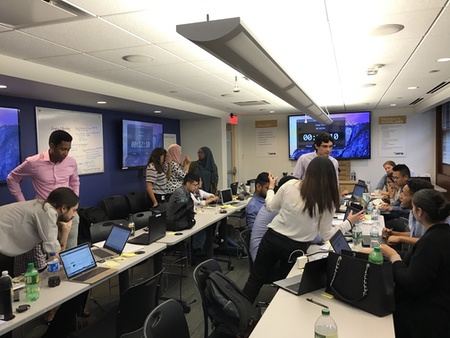I recently had the pleasure of conducting Scrum.org’s Professional Scrum Foundations workshop to a group of students at the nonprofit job-training program, Year Up, in Boston. Teaching this group of millennials -- motivated, talented young adults from low-income background -- was an illuminating experience that ended up teaching me something about being a Scrum trainer as well as the future of software development.
Year Up is a nonprofit organization whose mission is to provide low-income youth, ages 18-24, with the skills, experience, and support that will empower them to reach their potential through professional careers and higher education. Scrum.org has been working with Year Up for the last year, and this was our first experiment including our material as part of their curriculum.

Here what I learned:
Gross generalization alert! I know that what follows may not apply to every millennial out there, but it was striking how the traits I observed spanned everyone in the class.
1. It’s easier and more fun to teach Scrum to people who are optimistic and open-minded
As a Professional Scrum Trainer, I have taught Scrum to hundreds of participants. For the most part, these people bring to class many years of experience in software development and unfortunately, with that experience comes a lot of baggage:
"This won't work here."
"We've been through these things before."
"How can I do this on top of what I'm already doing?"
"Things won't change here."
The great thing about teaching Scrum to people early in their careers is their optimism about trying something new. This group of young people was free of the entrenched attitudes that limit possibilities. Whether investing in mutual funds or engaging in complex work, it pays to remember that, "past performance is not an indicator of future outcomes.” This group of Millennials embrace this principle.
2. A predictive approach to solving problems is intuitively stupid if you’ve never done it that way
One of the things I do when teaching Scrum is to compare it to what came before Scrum: waterfall.
Because Year Up participants had no experience delivering software using waterfall, rather than give them a history lesson, I talked about developing software through a process of creating a detailed up-front plan and then executing it without accounting for the possibility of the plan being wrong. “Do step A, then step B, then steps C through Z and in six months, you're done!”
After I explained this process to them, they looked at me like I was from a different planet and said things such as:
"How would that ever work?"
"But, so much would change in six months."
These students have experienced so many changes in technology over a relatively short time that they intuitively understand that change is going to happen no matter how well thought out the plan is. They didn't have to live through several failed projects to know just how dumb this whole idea is.
3. Millennials like to solve problems
One of the things I love about the Professional Scrum Foundations workshop is that it focuses on doing. Participants begin the class by breaking out into teams and building a website. I often hear a lot of objections to this activity in my classes:
"We don't know how to build websites."
"We don't have the right tools."
"We don't have enough information."
In my classroom full of millennials, I heard none of this. When I turned them loose on the activity, they jumped at the opportunity. They quickly broke up the work and started tackling the problem. Were the results messy? Sure, but no more so than with all the other classes I've taught. The point of this exercise isn't to be perfect; the point is to learn about the problem you’re trying to solve. Learning by doing is critical in Scrum. When you’re building something that you’ve never built before (which is almost everything in software development), the best way to make progress isn’t to study the problem; it’s to experiment. This group of millennials did this without any of the negativity or defeatism displayed by many of my other students.
4. Millennials have high emotional intelligence
One of the key practices in Scrum is the Sprint Retrospective. This event gives everyone an opportunity to inspect how they're functioning as a team and to suggest improvements. It can be quite challenging for some participants, as it often requires difficult conversations between team members. I routinely seen training participants struggle to confront team members who've been exhibiting behaviour that is detrimental to the team. The Year Up group had no problems talking to team members directly and respectfully. I witnessed a highly developed ability to function in a group setting and to provide actionable feedback.
5. Some traits span generations
Lest you think this cohort was entirely sweetness and light, there were some areas where these millennials were no different than my other students.
There was a similar fear when it came to calling out people in authority. Although they were adept at providing feedback to each other, they struggled to confront the dysfunctional behaviour of their bosses. The reluctance to criticise people “above them” was just as strong in this group as it has been in my other workshops.
They were also overly optimistic with how much work they could get done, just like every other person I've taught.The ability to forecast improves over time, but no one has ever underestimated how much work they could complete in the early exercises.
The future looks bright
Teaching this class was a gratifying experience and one that I hope to have again. I’m eager to see if the attitudes and behaviours I witnessed will be the same in other groups.
If these traits are indicative of the millennial generation, I'm very optimistic about what they'll accomplish when they start practising Scrum in the wild.
